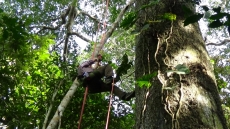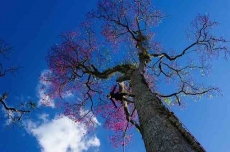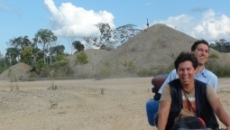We are delighted that "One Old Woman Up In a Tree" will premiere at the Short Hot Flush festival in Brighton on 3rd October
Katherine Holden decided to mark her 70th birthday by learning to climb trees. Not just any trees but the giants of the old growth forests like Mahogany and Red Wood. Katherine has always loved trees and as she stood firmly rooted in old age she knew it was her last chance to draw attention to the threats faced by forests around the world and the creatures that live in them. But she also understands the complexities of human need, greed and survival so she explores the issues with passion and compassion.
Katherine faced the challenge of tree climbing lessons, her upper body strength often letting her down, her memory struggling with the innumerable knots, and at age 71 she set off for the Peruvian Amazon to climb the Brazil Nut and Iron Wood trees now threatened by gold mining. She would have climbed a mahogany but there are none remaining in the area. Award winning filmmaker Hazel Chandler traveled with her, along with tree climbing assistant and photographer Leo Principe.
THE PERUVIAN SITUATION Deep in Peru's Amazonian rain forest, in Madre De dios, a region which has already lost over 28,000 hectares of forest, an area equivalent to the Maldives, to logging and agriculture, gold mining is now the biggest threat to forest, wildlife and humans- not just because the mining destroys the land but also because the mercury used in the mining process is contaminating the water. 45 tons of mercury are dumped into the rivers every year and A recent report found unsafe levels of mercury in almost 80% of people in Puerto Moldanado, the capital of the Madre De Dios.
Since the International financial crisis, which led to the price of gold rising as high $1800 per ounce, this influx in gold mining has pushed Peru to 5th place in the world's gold production producing 10 billion dollars worth of gold per year and in Madre de Dios, over 100,000 dollars of gold is mined, from the Madre De Dios river, every day The huge profits from illegal gold mining have fueled corruption and attracted local and international organized crime groups.
Over the past 10 years, around 40,000 illegal miners have come to try their luck and Madre de Dios has become one of the largest centres of sexual and labour exploitation in Peru, largely due to the spread of illegal gold mining in the region which has brought with it a wide range of forms of contemporary slavery -most prominently trafficking in girls and young women from impoverished rural areas who are promised jobs and are then forced into prostitution.
Many of the miners come from poor mountain regions like Puno or Cuzco where they struggled to survive. What they earn mining is a considerable improvement on what they fled from but it is by no means the riches that many imagine. They are frequently moved on by government raids which also destroy their machines and fabricated housing.
The land issues are very complicated. There are national reserves and around those reserves are buffer zones which have already been penetrated. Most miners have been trying to legalise their status but a complicated bureaucratic process has made it almost impossible. The 33 Indigenous peoples in the region are also now becoming aware of their rights and trying to claim back their lands.
The destruction from gold mining is more absolute than that from logging or agriculture. It Strips away the surface and can go 50 feet down. A few small organisations are working with miners to try and encourage clean ways of mining without using mercury, but these are expensive.
To date, all of the government’s attempts to curb the illegal mining have been unsuccessful, partially due to corruption at local and national levels and partly due to the backlash that authorities in Lima face from the thousands of miners when they take to the streets to protest.
A recently completed bridge across the Madre de Dios river, connecting Peru and Brazil, just adds to the ease of access and therefore the devastation. The governments haphazard approach to controls, swinging from ignoring the problem to raids on mining camps, only serves to perpetuate the notion that there is corruption in high places. Up to 98% of miners in the Madre de Dios are illegal and are amongst the poorest, more marginalised people in the world. Getting rid of them would only force most of them back to poverty and the threat of starvation. Meanwhile one of the most bio diverse regions in the world, an area that holds 25% of the world's species, is rapidly disappearing and human trafficking is out of control.
|
|




